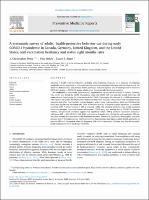Please use this identifier to cite or link to this item:
https://hdl.handle.net/20.500.12202/9456| Title: | A systematic survey of adults’ health-protective behavior used during early COVID-19 pandemic in Canada, Germany, United Kingdom, and the United States, and vaccination hesitancy and status eight months later |
| Authors: | Perry, J Christopher Starrs, Claire J Békés, Vera 0000-0003-3043-5155 Bekes |
| Keywords: | Adults COVID-19 Canada German Health-protective behaviors Survey USA United Kingdom Vaccine adoption Vaccine hesitancy |
| Issue Date: | 2022 |
| Publisher: | Elsevier |
| Citation: | Perry, J. C., Békés, V., & Starrs, C. J. (2022). A systematic survey of adults’ health-protective behavior used during early COVID-19 pandemic in Canada, Germany, United Kingdom, and the United States, and vaccination hesitancy and status eight months later. Preventive Medicine Reports, 30, 102013. |
| Series/Report no.: | Preventive Medicine Reports;30 |
| Abstract: | Adoption of health-protective behaviors, including social distancing measures, are a mainstay of mitigating pandemics, so it is important to understand the characteristics associated with those who use them or not. We aimed to delineate local and personal factors associated with self-reported use of health-protective behaviors (HPB) in response to COVID-19, among adults across 4 economically developed countries. We conducted an exploratory, cross-sectional, representative, on-line survey of adults in Canada, Germany, U.K., or the U.S. during the COVID-19 pandemic (June-July 2020) with two and eight month follow-ups. All countries were experiencing the initial waves of the COVID-19 pandemic. We obtained N = 6,990 participants, who reported 20 specific health-protective behaviors (dependent measure), along with locally mandated health measures, individual characteristics and psychological scales. Using health-protective behaviors (HPB-Quartile score) was significantly associated with 28 of 35 variables studied. In stepwise logistic regression, 21 variables predicted 23.51 % of the variance in HPB-Q scores (p <.000). The strongest predictors were locally mandated protective measures, immature defense mechanisms, COVID-fears, age, moving due to COVID-19, domestic violence, and perceived emotional support from significant others. HPB-Q predicted vaccination hesitancy/willingness (OR = 4.61, CI-95 %: 2.66-8.00) and adoption 8 months later. During the early pandemic, HPB use was most strongly associated with locally mandated measures, followed by psychiatric, demographic, and other personal factors. Considering these empirically derived characteristics may improve public health approaches to optimize HPB and vaccination adoption, mitigating SAR-CoV-2 transmission. Findings may also inform public health responses to future epidemics/pandemics. |
| Description: | Scholarly article /Open Access |
| URI: | https://pubmed.ncbi.nlm.nih.gov/36246769/ https://hdl.handle.net/20.500.12202/9456 |
| ISSN: | 2211-3355 (online) |
| Appears in Collections: | Ferkauf Graduate School of Psychology: Faculty Publications |
Files in This Item:
| File | Description | Size | Format | |
|---|---|---|---|---|
| Bekes 2022 OA A systemic survey.pdf | 411.65 kB | Adobe PDF |  View/Open |
This item is licensed under a Creative Commons License

